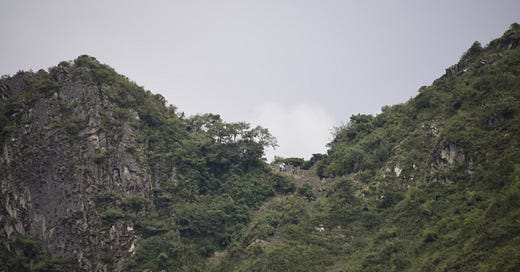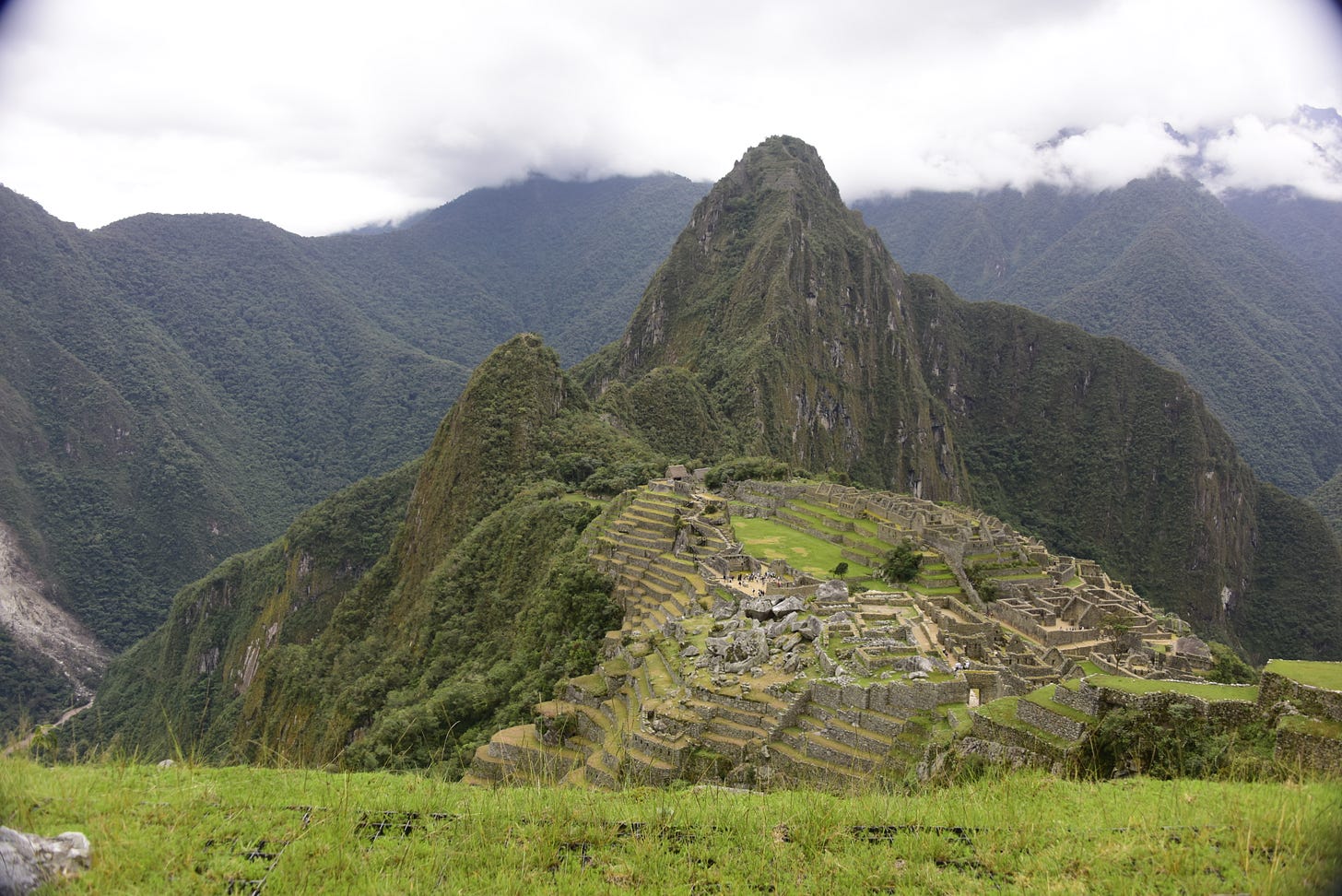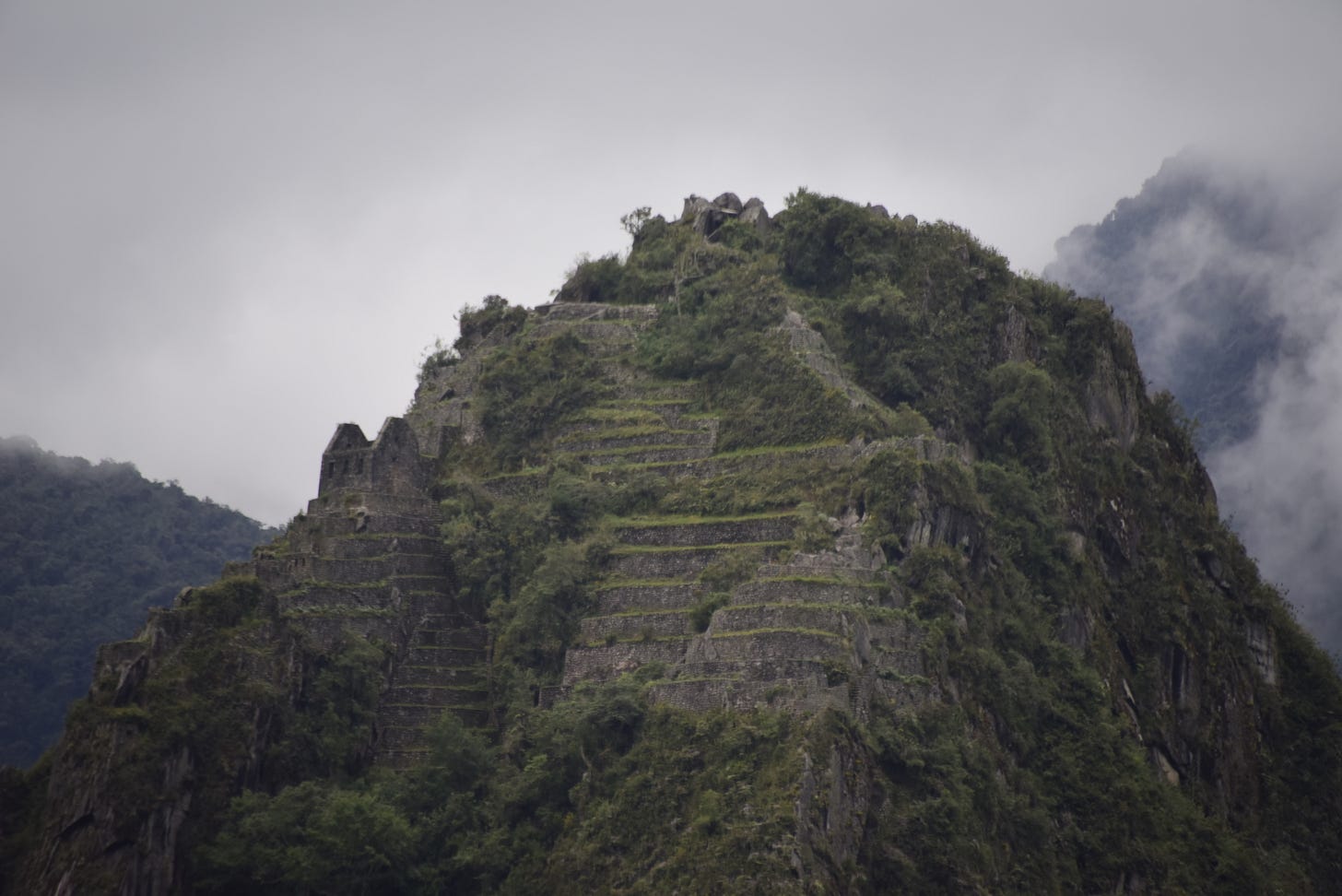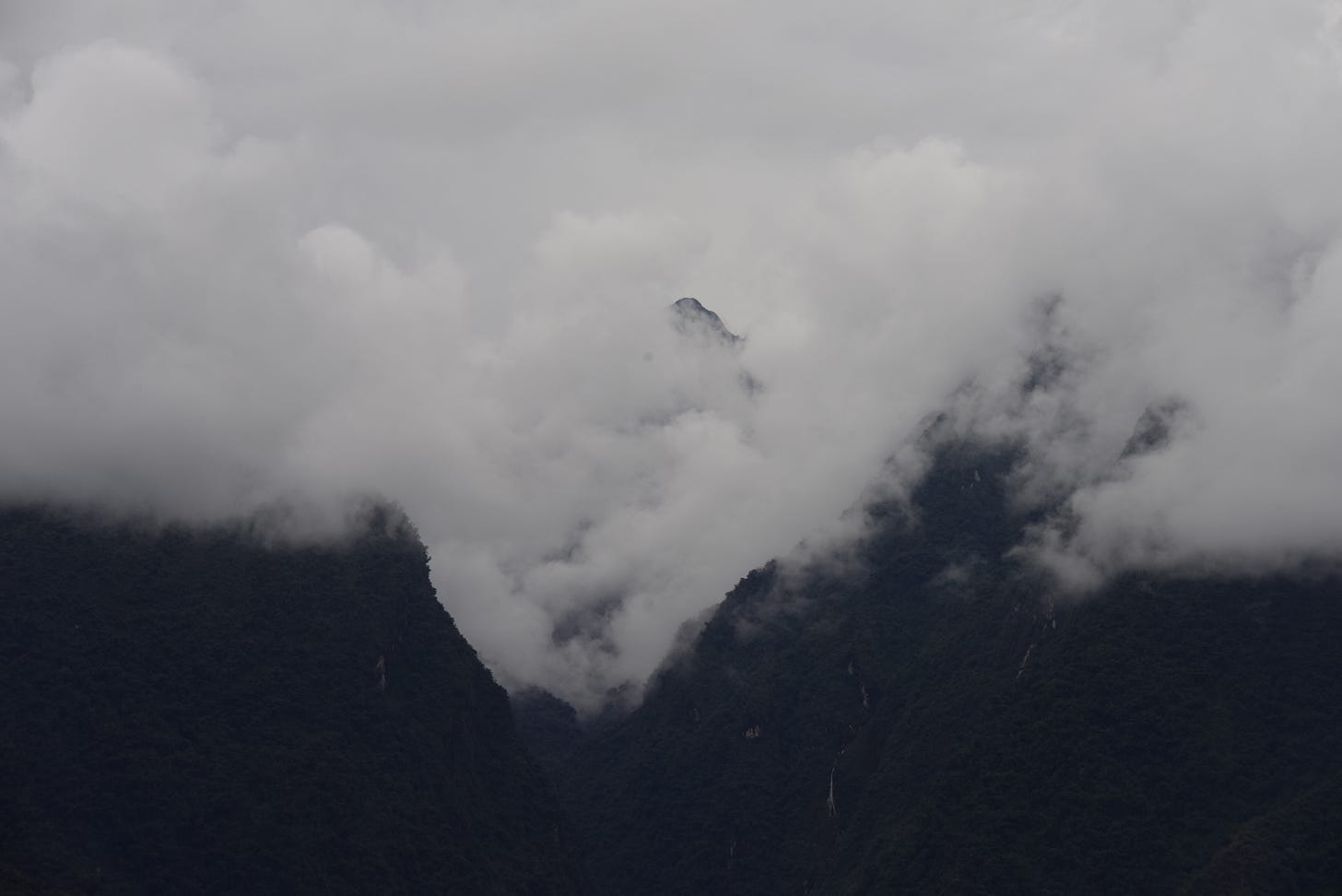Prelude
The Finding of Machu Picchu
On the morning of July 24, 1911, an enterprising lecturer-explorer from Yale University set off in a cold drizzle to investigate rumors of ancient Inca ruins in Peru. The explorer chopped his way through thick jungle, crawled across a "bridge" of slender logs bound together with vines, and crept through underbrush hiding venomous fer-de-lance pit vipers.
Two hours into the hike, the explorer and his two escorts came across a grass-covered hut. A pair of local farmers walked them a short way before handing them over to a small boy. With the boy leading the way, Hiram Bingham stumbled upon one of the greatest archaeological finds of the 20th century—and what was named in 2007 as one of the new seven wonders of the world: Machu Picchu.
What Bingham saw was a dramatic and towering citadel of stone cut from escarpments. Fashioned by men without mortar, the stones fit so tightly together that not even a knife's blade could fit between them. He wondered: Why? By whom? For what?
Certainly, what he saw was awe-inspiring. Contemporary Peruvian expert Luis Lumbreras, the former director of Peru's National Institute of Culture, describes "a citadel made up of palaces and temples, dwellings and storehouses," a site fulfilling ceremonial religious functions.
Machu Picchu is formed of buildings, plazas, and platforms connected by narrow lanes or paths. One sector is cordoned off to itself by walls, ditches, and, perhaps, a moat—built, writes Lumbreras, "not as part of a military fortification [but] rather as a form of restricted ceremonial isolation."
Bingham's discovery was published in the April 1913 issue of National Geographic magazine, bringing the mountaintop citadel to the world's attention. (The National Geographic Society helped fund Bingham on excursions to Machu Picchu in 1912 and 1915.)
Bingham believed he had found Vilcabamba, the so-called Lost City of the Inca where the last of the independent Inca rulers waged a years-long battle against Spanish conquistadors. Bingham argued for and justified his conclusions for almost 50 years after his discovery, and his explanations were widely accepted.
What Bingham had found, however, was not the lost city, but a different lost city.
In 1964, adventurer Gene Savoy identified ruins and proved that Espiritu Pampa (in the Vilcabamba region of Peru, west of Machu Picchu) was the lost city that Bingham had originally sought. Ironically, Bingham had actually discovered these ruins at Espiritu Pampa during his 1911 trek. He uncovered a few Inca-carved stone walls and bridges but dismissed the ruins and ultimately focused on Machu Picchu. Savoy uncovered much of the rest.
In Bingham’s Footsteps
Our trek to Machu Picchu started at 7:30 am. We were transported from the hotel some distance to a railway station, going through the old town of Cuzco with its narrow, cobbled streets and through what was described as the bad part of town which was no more nor less than a slum. Rubbish lay all over the streets. Dogs rummaged through what was there. Small sidewalk stalls sold items of food and fruit but the clear impression was one of bare survival level poverty.
The buildings were shanties – cardboard and plywood. Electricity was present but with wiring that clearly would not comply with any safety standards with which I was familiar. This was not a safe part of town to walk alone nor as a group. I thought of the concerns expressed by Chloe Swarbrick and Marama Davidson speaking from the comfort of their bourgeois offices or dwellings, railing against poverty. They have no idea of what real poverty looks like. And if this part of Cuzco was bad, the slums of Lima were ten times worse, situated as they are on the banks of the main river which supplies Lima with its water. It is small wonder that the water from the tap is unsafe to drink.
We arrived at the railway station – a stark contrast to some of the places we had driven through – and joined the Hiram Bingham Train to Aqua Caliente – also known as Machu Picchu Town.
The carriages bore a resemblance to the dining cars on the Orient Express in Europe. Well appointed, comfortable, tables for 4 or for two, brilliant white linen and excellent service for food and drink. A luncheon menu was on the table and lunch was served during the trip. No sandwiches in a brown paper bag – it was silver service all the way and very well done.
The train journey took just under three hours and wound through the valleys of the lower parts of the Andes. Machu Picchu is situated at a lower altitude than Cuzco so the journey was, imperceptibly, a downhill one. As we went through the valleys we could see farmland plots where fields of corn and potatoes were growing, until the passes became steeper and alongside the tracks was a fast flowing rock and rapid filled brown river which ran to a hydro station (not a dam but a generation plant) and carried on until ultimately it joined the Amazon.
Craggy peaks on either side, some topped with snow, some with sides that seemed impossibly tall, impossibly sheer, soaring up to 18,000 feet.
Finally we reached Aqua Caliente and disembarked – a short walk through the markets which sold souvenirs as one might expect. To the bus station where we joined a bus for a 30 minute trip to the starting point for the ascent to Machu Picchu.
Our group of seven had reduced to five and it was not long before two of our number realised that what faced them was no picnic, so they chose to remain in the refreshment area. Now we were three, accompanied by our guide Liss.
There was a short but steep climb to the starting point where the track branched into three. One track was relatively flat and was an easy climb to the site. The second track was a little steeper and the third track was the toughest of all. Liss explained the advantages and disadvantages of the three options. After a brief consultation we decided we would take the tough trek and tough it was -although the path is clear and paved, the paving is rough and uneven and the ascent is steep and winding. On one side was the jungle and as we ascended on the other side was a drop off which grew to a couple of thousand feet to the valley floor below and, when we got to Machu Picchu, down in an impossibly steep valley flowed the river which accompanied us on the train ride.
Liss was fantastic. She carefully explained where we were going and what we could see from the various vantage points. She was careful to ensure that we could cope with the climb – it was very, very steep – but we were fine. She ensured that at each stop we had some water. Hydration is essential not only in terms of the effort but as a counter to the effects of altitude. The medication that we had taken for altitude sickness worked a treat. No ill effects at all, although the strenuous climb took its toll on knees and leg muscles.
As we approached the top of the climb Liss pointed to a gap in the mountains nearby, telling us that was where the Inca trail came out. The Inca trail is the other way in to Machu Picchu and is a 4 day expedition from start to finish. It is reasonably well laid out but is by no means level – no, not at all. Going to Machu Picchu via the Inca trail involves three camp sites on the way all of which are set up by guides who take the keen tourists through. And it is not for the faint-hearted.
The distance of the Inca trail is about 29 miles but some of the Indian inhabitants of the mountains can run the trail in little over three and a half hours wearing traditional sandals!
And so we came to the end of the trail and there was Machi Picchu below us.
There was more to it than is shown in the tourist photos and the site is quite extensive. On the mountain to the rear of the site terracing can be seen at the summit which was the site of the Temple to the Moon. Extensive terracing surrounds the site and llamas (along with gardeners with whipper snippers) keep the grass down.
What is surprising about Machu Picchu is that it is a work in progress. Some parts have been reconstructed, others are in their original condition. But what has been revealed is only part of the site – the estimate is 40%. In the jungle, on the precipitous slopes of the mountains, there is more terracing yet to be uncovered. The community of Machi Picchu in the days of Atahualpa was quite extensive. But the purpose of Machu Picchu is still something of a mystery. Some theories have it as an educational institution. Others suggest it is a religious site and there is evidence of that. But it is far more extensive than a mere place of worship. It seems that the terracing allowed for extensive cultivation and that the community was self-supporting.
There were no accounts of Machu Picchu in any of the much-studied chronicles of the Spanish invasion and occupation, so it was clear European invaders had never discovered it. There was nothing to document that it even existed at all, let alone its purpose.
Bingham theorized that Machu Picchu had served as a convent of sorts where chosen women from the Inca realm were trained to serve the Inca leader and his coterie. He found more than a hundred skeletons at the site and believed that roughly 75 percent of the skeletons were female, but modern studies have shown a more reasonable fifty-fifty split between male and female bones.
Modern research has continued to modify, correct, and mold the legend of Machu Picchu. Research conducted by John Rowe, Richard Burger, and Lucy Salazar-Burger indicates that rather than being a defensive stronghold, Machu Picchu was a retreat built by and for the Inca ruler Pachacuti. Burger has suggested it was built for elites wanting to escape the noise and congestion of the city.
Brian Bauer, an expert in Andean civilization at the University of Illinois at Chicago and a National Geographic grantee, says Machu Picchu—which was built around A.D. 1450—was, in fact, relatively small by Inca standards and maintained only about 500 to 750 people.
One thing is certain, says Bauer, archaeological evidence makes it clear that the Inca weren't the only people to live at Machu Picchu. The evidence shows, for instance, varying kinds of head modeling, a practice associated with peoples from coastal regions as well as in some areas of the highlands. Additionally, ceramics crafted by a variety of peoples, even some from as far as Lake Titicaca, have been found at the site.
"All this suggests that many of the people who lived and died at Machu Picchu may have been from different areas of the empire," Bauer says.
As for farming, Machu Picchu's residents likely made use of the grand terraces surrounding it. But experts say these terraces alone couldn't have sustained the estimated population of the day and that farming most likely also took place in the surrounding hills.
Dr. Johan Reinhard, a National Geographic explorer-in-residence, has spent years studying ceremonial Inca sites at extreme altitudes. He's gathered information from historical, archaeological, and ethnographical sources to demonstrate that Machu Picchu was built in the center of a sacred landscape.
Machu Picchu is nearly surrounded by the Urubamba River, which is revered by people in the region still today. The mountains that cradle the site also are important sacred landforms. "Taken together, these features have meant that Machu Picchu formed a cosmological, hydrological, and sacred geographical center for a vast region," Reinhard says.
It is an understatement to say that the site is impressive. It is more than that. Surrounded by Andean peaks, often on the same level as the clouds themselves, it is an awe inspiring place.
We were lucky that in the four hours that we were there we avoided the rain although we could see rainclouds emptying out in some of the nearby valleys, covering the view with an opaque mist. Occasionally the clouds would be split by lightning flashes and thunder roared and echoed through the peaks and down the valleys.
It was time to go so Liss took us to the starting point on the easy trail which took about 10 minutes and was an easy walk. Just as we arrived, ready for a cup of coca tea, the rain started.
The return to Cusco was by bus to Aqua Caliente and by train to our starting point and thence by bus to our hotel. The stalls in the slums were closed, covered by plastic and the dogs had gone to wherever it is that street dogs go.
At the hotel, a hot shower and so to bed.
Some of the material and quotes contained in this article come from The National Geographic webpage on Machu Picchu which can be found at https://www.nationalgeographic.com/history/article/machu-picchu-mystery?loggedin=true&rnd=1704161634292








Ah, still a magical adventure, you captured it well. When we went in the 1970's there was a very small, discrete, 7-room hotel on site where we stayed overnight and had the place to ourselves in the evening and morning before the day tourists arrived. We climbed to the pass to the Inca trail and were captivated by a Condor lazily spiralling on the air currents above us. We also climbed up the 'sugar loaf' peak which was a bit intrepid! I enjoyed the more historic details than we ever heard - thank you.